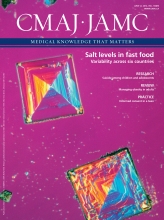Venous thrombosis and non-oral hormonal contraception
Women who use transdermal patches or vaginal rings for contraception have an increased risk of venous thrombosis compared with nonusers. A retrospective cohort study used data from four national registries in Denmark to assess the risk of venous thrombosis associated with use of transdermal, vaginal, intrauterine or subcutaneous hormonal contraception. Non-pregnant women aged 15 to 49 years (n = 1 626 158) and who had no previous thrombotic disease or cancer were included in the 10-year study (from 2001 to 2010). During the study period, 5287 first-ever events of venous thrombosis were recorded, with 3434 confirmed through prescribed anticoagulation therapy. The adjusted relative risk (RR, adjusted for age, calendar year and education) was 7.90 (95% confidence interval [CI] 3.54 to 17.65) for the patch and 6.48 (95% CI 4.69 to 8.94) for the vaginal ring, compared with women who did not use hormonal contraception. The risk of venous thrombosis was not increased with use of subcutaneous implants (RR 1.40, 95% CI 0.58 to 3.38) and levonorgestrel intrauterine system (RR 0.57, 95% CI 0.41 to 0.81). Data on smoking were not available. See BMJ 2012;344:e2990 doi: 10.1136/bmj.e2990.
Infectious outcomes after splenectomy
After splenectomy, the incidence of severe infection and mortality is highest among the elderly and those with cancer, and lowest among patients who had splenectomy after trauma. Almost 2500 adult patients who had undergone splenectomy were included in a retrospective cohort study that used a linked hospital discharge dataset in Australia. The most common reasons for splenectomy were trauma (25.7%) and treatment for hematologic disease (23.6%). During eight and a half years of follow-up, 26% of patients (644/2472) had experienced a severe infection, most commonly respiratory (38.2%) and sepsis (15.1%), requiring hospitalization. The incidence of first severe infection was highest in people 50 years of age or older (10.1 per 100 person years, 95% confidence interval [CI] 9.3 to 11.1) and in those who had undergone planned splenectomy for malignancy (14.2, 95% CI 11.8 to 17.1), and lowest in those under 50 years and after splenectomy for trauma. The results were similar for sepsis and all-cause mortality. The authors suggest that targeted prevention programs may be appropriate after splenectomy. See MJA 2012;196:582–6.
Pulse oximetry screening for critical congenital heart defects
Pulse oximetry is highly specific for the detection of critical congenital heart defects with moderate sensitivity in asymptomatic newborn babies and should be considered for universal screening, say the authors of a systematic review and meta-analysis. Thirteen studies (12 cohort and 1 case–control) with data for 229 421 babies were included in the analysis. The overall sensitivity of pulse oximetry for detecting critical heart defects (i.e., in which all infants die or need surgery in the first 28 days of life) was 76.5% (95% confidence interval [CI] 67.7 to 83.5), whereas the specificity was 99.9% (95% CI 99.7 to 99.9). The false-positive rate was 0.14% (95% CI 0.06 to 0.33) and was affected by the timing of the test. The false-positive rate was lower if the test was performed 24 hours or later after birth rather than within the first 24 hours. See Lancet 2012; DOI:10.1016/S0140–6736(12)60107-X.

Image courtesy of © 2012 Thinkstock
Estimating the glomerular filtration rate
The new Chronic Kidney Disease Epidemiology Collaboration (CKD-EPI) equation classified fewer people as having chronic kidney disease and more accurately categorized the risk of mortality and end-stage renal disease than the commonly used Modification of Diet in Renal Disease (MDRD) Study equation. Data from 1.1 million adults from 45 cohorts (25 general populations, 7 at high risk for vascular disease, and 13 with chronic kidney disease) were included in a meta-analysis evaluating the risk implications of using the equations to estimate glomerular filtration rate (GFR). The CKD-EPI equation reclassified 24.4% from general population cohorts to a category with higher GFR and 0.6% to a category with lower GFR, resulting in a reduction in the prevalence of advanced chronic kidney disease stages (8.7% to 6.3%). The study outcomes (incidence rates of all-cause mortality, cardiovascular mortality and end-stage renal disease) were reduced in those who were reclassified. Net reclassification improvements based on estimated GFR categories were found for most populations, subgroups (e.g., age, sex, race or ethnicity, and comorbidities [diabetes, hypertension]) and outcomes. See JAMA 2012:307:1941–51.











